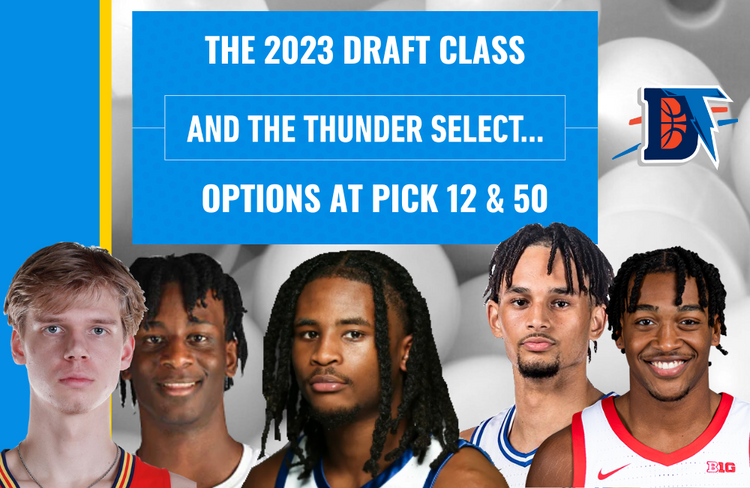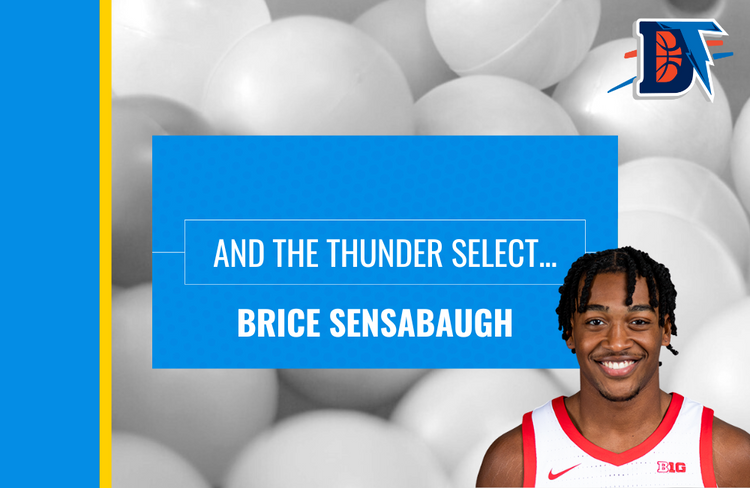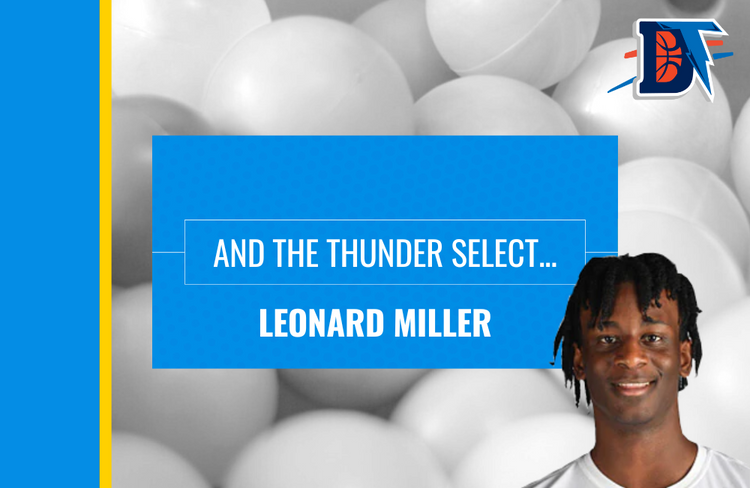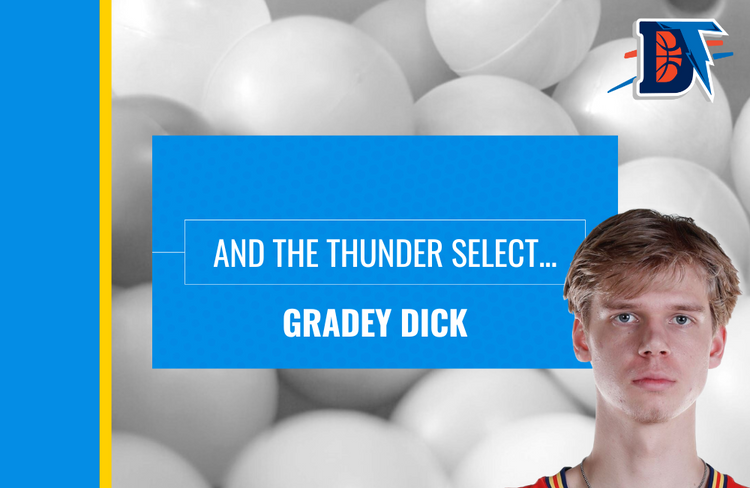And the Thunder Select: Scottie Barnes
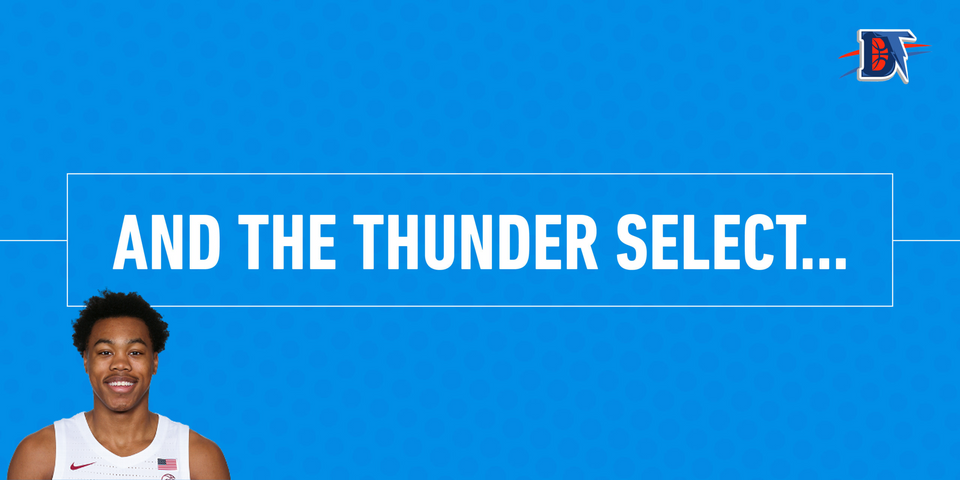
With the Thunder ending up with the sixth pick in the draft, let’s take a look at some of the options that could possibly be available, starting with former Florida State player Scottie Barnes. We’ll go over his strengths and weaknesses and touch on how he’ll fit with this current Thunder core of young players.
- Born: August 1, 2001
- Draft Age: 20.0
- High School: Montverde Academy
- RSCI: 5
- College: Florida State University
- Measurements: 6’8, 225.4 pounds, 7’2.75” wingspan
- Consensus Ranking: 5th
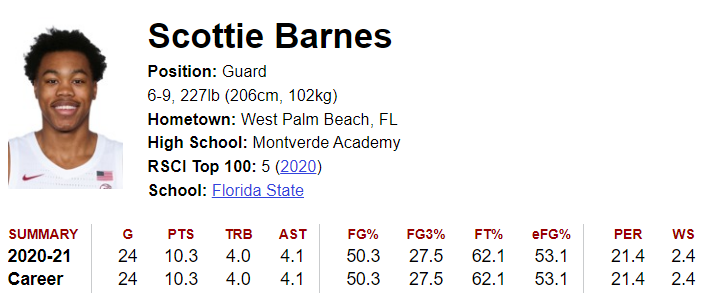
Shades Of: Kyle Anderson, Justise Winslow, Ben Simmons
Scottie Barnes came into Florida State as one of the most hyped recruits in the nation. He finished his career at Montverde Academy in Florida, arguably the greatest high school team of all time that featured future pros like Cade Cunningham, Moses Moody, Day’Ron Sharpe, Caleb Houstan, and more.
At Florida State, Barnes averaged 24.8 minutes per game, alternating between starting and coming off the bench for the Seminoles as a true freshman. He led the team in usage and ran the offense a majority of his minutes as a 6’8 jumbo initiator. Without much stand-still burst or vertical explosion, Barnes used his height, strength, and length to create advantages for himself and set up himself and his teammates for open shots.
Despite being primarily deployed as a lead ball-handler, I don’t think that’s where he’s going to end up playing in the NBA. Barnes definitely projects as a big man at the next level and I think he’ll spend a majority of his minutes at the four while occasionally slotting in as a small-ball five (more on that later). The skills that Barnes possesses are tantalizing and in line with what a lot of current and future prospects are bringing to the table, big men who can handle and pass the ball. He’s a great connecting piece in an NBA offense, playing off advantages that players like Shai can create when he draws a double team, etc. All of these attributes add up to an intriguing and potentially very valuable player in the modern NBA and a player that can recoup the value of the sixth overall pick.
Let’s start with Barnes’s most intriguing skill on offense, his passing.
Playmaking:
Last season for the Seminoles, Barnes was the only high-major player to be 6’8 or taller and post a 30+ assist rate, as he led his team in assists/40 at 6.6 assists per game. He showcased his passing during his high school career, but on a team with Cade Cunningham and Ryan Nembhard on it, frequent initiator reps were hard to come by for him. At Florida State, Barnes was immediately put into a playmaking role and became the team’s primary point guard.
At 6’8, Barnes truly is a great passer. Even going back to high school, he was flashing these high-level reads all the time at Montverde and even at U-School. He is really effective at manipulating defenders with his eyes like a quarterback to create open looks for his teammates.
Not only is Barnes successful in the half-court, but he’s shown to be dynamic in transition opportunities as well, always keeping his eyes up the court and looking for teammates running out for open shots.
His most successful area of operation during his NBA career might be at the elbow/high post, where he can survey the floor and make quick decisions, something that he does very well. Last season for the Thunder, Al Horford worked a lot of his game in this area of the floor, reading the defense and making passes to cutters or open shooters on the wing. This isn’t comparing the two players at all, but more talking about the kind of actions that Barnes might be involved in early in his career. The potential to be an offensive hub within the middle of the floor is within the realm of possibility for Barnes. With Horford gone and OKC lacking quick decision-makers in the frontcourt outside of Kenrich Williams, this will be a major addition to OKC’s offense next year.
As mentioned above, Barnes was excellent at finding cutters in his one year at Florida State, routinely nailing bounce passes in-between defenders for easy layups and dunks.
One thing that I’m confident we’ll see if Scottie is drafted by OKC is heavy involvement in the short roll. With the combination of Barnes’ quick processing and decision making, Shai’s PnR excellence, and Mark Daigneaults five-out offense, this can be an area where Barnes can thrive immediately without worrying about creating an advantage for himself. His catch-radius is massive with his long arms and big frame, which helps when reaching for possible errant passes thrown to him.
This is the quintessential Barnes pass in my opinion, making an excellent skip pass out of a double team. His size is what makes him be able to get this pass off with relative ease, as no 6’4 player will be making that overhead skip pass to the opposite corner. The decision-making is on display here as well. He reads the floor incredibly well for a 6’8 big and while he isn’t doing much in terms of passing players open, he almost always makes the right read on the floor.
My main concern with Barnes and his playmaking is how functional his passing is at the next level relative to his draft stock. Routinely mocked at picks 5-7, I’m not sure he creates enough advantages due to his lack of burst and outside jumper to consistently create open looks for others or himself when he has the ball in his hands on the perimeter. Now with Shai on this team, it might not matter nearly as much because Shai is one of the best shot creators in the entire NBA and can amplify Barnes’ skills as a connecting piece rather than a primary ball-handler. The height, quick decision making, and above-average passing is a high-floor skillset in his toolbox that can be even more valuable if the other avenues of offense improve for him.
Scoring:
The finishing is the best aspect of Barnes’ offensive game outside of his passing ability. He shot 68.5 percent at the rim this past season while being assisted on 23 percent of his makes, per Bart Torvik. His length and near 7’3 wingspan really help him around the rim, where he flashed Giannis-lite extension dunks and finishes in traffic. There are many off-balance two-point shots that he attempts around the rim, with running hook shots and push shots over smaller defenders, and he has fairly good touch on these despite them being not the greatest shot in terms of efficiency. He’s able to create advantages for himself with his strength when he’s driving to the rim and getting defenders off of him in traffic.
Here he is blowing by Scottie Lewis, who is a great defender in his own right, in the open floor for the monster dunk. Passing aside, Barnes is a nightmare in transition for defenses. He’s fairly fast in a straight line and is a tank physically, being able to bully and run right through awaiting defenders and finish over the top of them. Barnes isn’t shy of contact and is a strong dude, so his free throw rate last year of .338 is something I see sticking around that range in the NBA.
One thing I noticed while watching film was Barnes settling a lot for these floaters or push shots from about 10 feet out. Even with smaller and less physical players on him, when he isn’t able to get to the rim he tends to resort to these shots. On the year, he shot 39.4 percent on “other” two-point shots, which are essentially all non-rim two-point attempts. A play like this is something that you see quite often with Barnes, and while he may make it on occasion, this isn’t a shot attempt that you like in isolation. On the other hand, this may have to be a shot he has to take if he’s frequently used in the short roll and has opportunities for an open floater or push shot.
As far as the outside shot goes, it’s still very much a work in progress. The percentages were ugly (27.5 percent from three on 40 attempts, 62.1 percent from the line) and he had a hesitancy to shoot the three when given the chance. The lone bright spot I can point to is that he did shoot 30/40 from the line over the last three months of the season, including an 11/12 month of March. I’m not an expert by any means, but two issues I see with Barnes’ jumper are the very wide base (legs are too far apart) and the lack of bend in his knees. He takes some time to get set and was pretty much a strict C&S player at Florida State.
This three-point attempt looks pretty open to me once he crosses over behind the screen. The slow-release and basic hesitancy to shoot the three can be pretty damaging to an offense, especially in the playoffs. He only took 40 threes all year, so the volume or the percentages aren’t there, and it doesn’t look like it’s going to be successful in the NBA the way his jumper is currently constructed. If there was any prior success with the form for Scottie then this wouldn’t be much of a concern, but there hasn’t been, even dating back to high school. There might have to be an overhaul in that department if you want to extract maximum value from Barnes.
Defense:
Barnes’ consensus calling card as a player is his versatile defense. He’s an incredibly smart player on that end, constantly pointing teammates in the right direction and consistently making the right rotations. He was tasked with guarding 1-5 at Florida State and did it well every time. Because of his elite length and strength for his position, he’ll likely be able to guard up and stay in front of a lot of guards and wings in the NBA. While he doesn’t have the quickest feet in the world, he’s able to hang at the POA because of this and would provide immense defensive value for the Thunder who don’t have a lot of defensive ability on the current roster.
Like most young prospects, Barnes is prone to his occasional mental lapses on the defensive end, whether that’s losing his man on a cut to the basket like the play below or just drifting in no-mans land. A few clips of him doing this were pointed out by Mike Schmitz during his film session with Scottie, and he seemed very self-aware of these lapses and recognizes that he needs to work on them (highly recommend you check out the interview here). Though despite these occasional lapses, Barnes effectively defended 1-5 in college and can likely handle 2-4 in the NBA and the occasional center.
Barnes is always communicating on defense. You can see him pointing and directing his teammates on defense and then ends up getting a great steal after crowding the ball handler. He put up good statistics in the defensive events department, ending the year with a 3.4 steal rate and 2.1 block rate. While not perfect or direct comparisons, I think you can see the similarities between these versatile point-forward type players with their stock (steals + blocks) numbers in their final year of college. Side note: Barnes briefly discussed his “lack” of blocks in the aforementioned film session with Mike Schmitz and said he tries to “wall up” as a defender instead of going for the block.
- Scottie Barnes: 3.4 steal rate, 2.1 block rate
- Ben Simmons: 3.1 steal rate, 2.5 block rate
- Kyle Anderson: 3.1 steal rate, 2.7 block rate
- Justise Winslow: 2.8 steal rate, 2.9 block rate
The length is really crucial for Barnes and his defensive prowess. He has the ability to contest almost any shot with his long arms and can make these clean blocks from behind without fouling. The weak side rim protection is a plus skill that he flashed a ton at FSU. His 7’2.75” wingspan was the sixth-longest at this year’s NBA Combine and he was the most athletic wing who tested according to bSPARQ score, provided by Nbathlete.
While this isn’t much of a predictive measurement, he did test extremely well and even impressed in some areas, specifically the shuttle run and the vertical, both standing and max. He finished second at the combine in the shuttle run at 2.99 seconds, third in standing vert at 36 inches, as well as coming in with a max vert of 39.5 inches. While not many players tested, these are impressive numbers for areas of his game that seemed like weaknesses before.
Regarding the agility drills, Barnes didn’t appear to be a very agile player when watching him this year. Not saying that it’s a negative by any means, but I’m uncertain if he can hang with most NBA shooting guards at the next level, but how many players of his size can? And the vertical was definitely a shocker to me. Despite multiple highlight-reel dunks on his tape, they happened more so because of his tremendous length and not because he’s a great vertical athlete. This factors into his defense as well, as many people are labeling him as a small-ball five and while I think he can do it in spurts, you can’t rely on him to be your primary rim protector because of his verticality.
The testing numbers are telling a different story, and maybe something was holding him back from showing this in college. I can’t say for certain though, and I said all of this to say that I’m questionable if he can consistently be a small-ball five, especially in the playoffs where you need rim protection at all times. He’s still a great defender, but the seeming lack of vertical explosion will hinder him in some spots.
Overall Thoughts:
I think Barnes is a worthy selection at sixth overall for this Thunder team. When I published my big board earlier, I had him ranked eighth overall but in the 5-10 tier of players, meaning I wouldn’t hate any of those guys at this selection.
Without many established players on the roster, fit shouldn’t matter with this Thunder team, however, I do like the pairing of Barnes and Poku together. Both are tall and relatively creative passers and have contrasting scoring styles, as Poku can be spaced out on the perimeter to give Barnes more room to work within the interior of the paint and vice-versa. While it isn’t with a guard, I think running inverted pick-and-rolls with Pokusevski as the ball handler and Barnes as the roll man on a spaced-out floor would be a fun combination. In addition to that, Shai’s shot creation, gravity, and PnR mastery should tilt defenses enough to where Barnes can attack and finish at the rim or dish out assists. Not to mention, Barnes and Dort would be an incredible defensive duo on the court together and would be nightmares to get by at the POA.
On the other hand, the spacing will be a concern unless OKC adds more shooters during the offseason. The Thunder were already one of the worst spaced teams in the league, and adding Barnes and possibly someone like Isaiah Jackson could mean a brief stunt in development, at least in year one. This is a slight concern though, and I’m advocating for taking BPA at this spot but this could be the reality for the first season with Scottie.
At the end of the day, Barnes is a great connecting piece with an incredibly valuable modern skillset, and he would bring a ton of energy and flair to a young OKC team with an already established star in Shai Gilgeous-Alexander.

